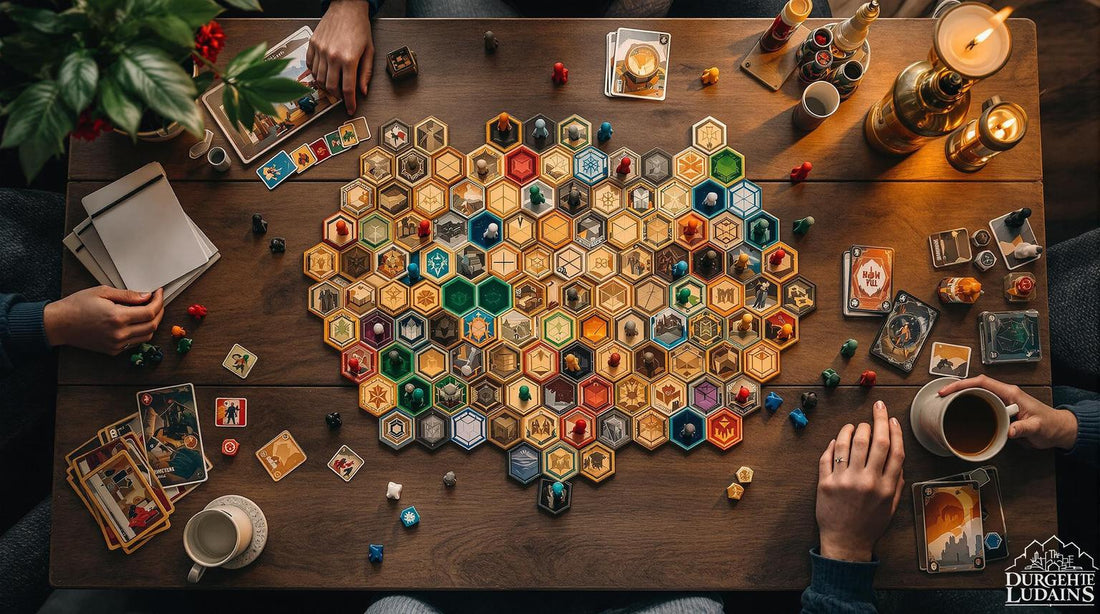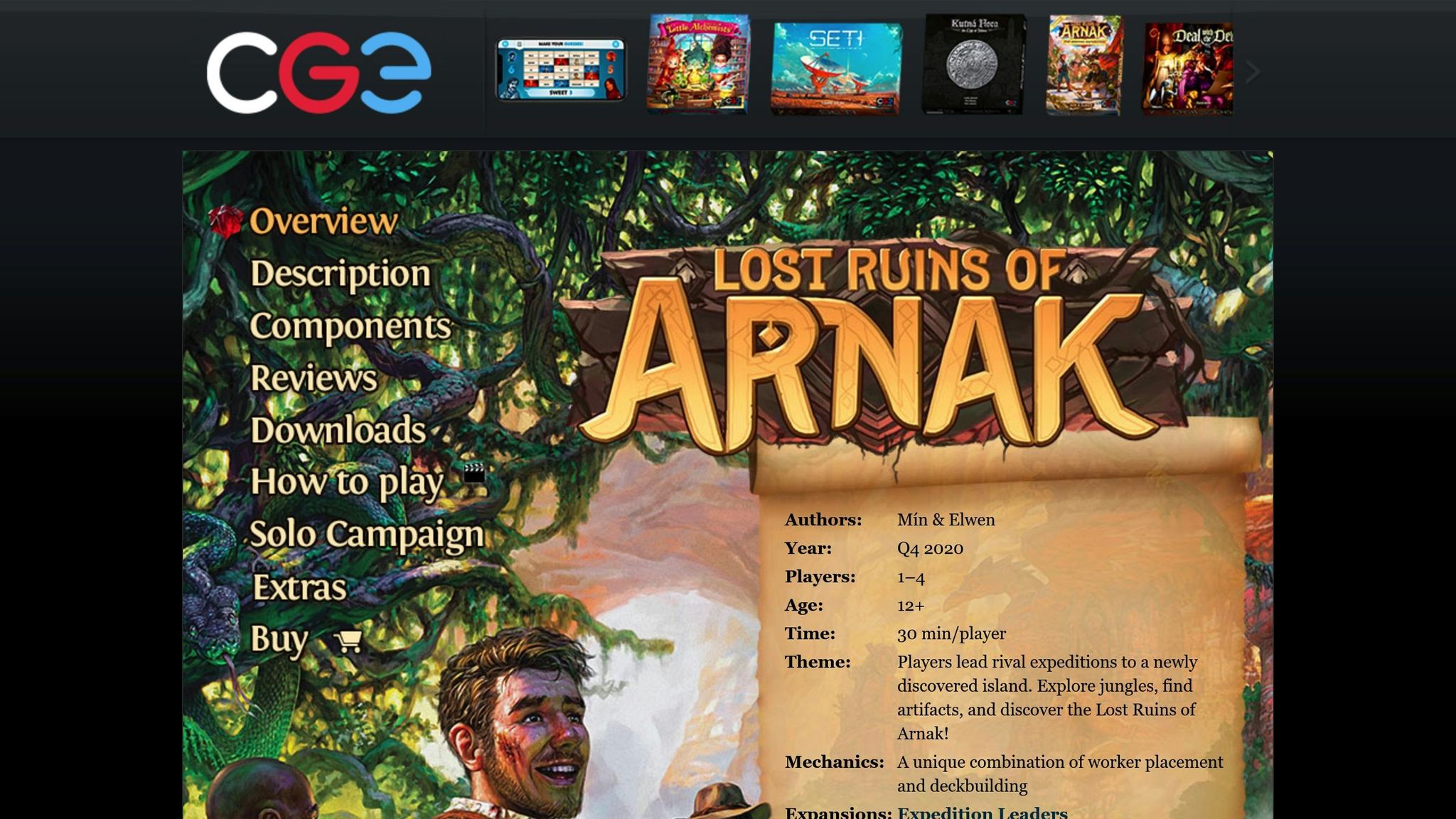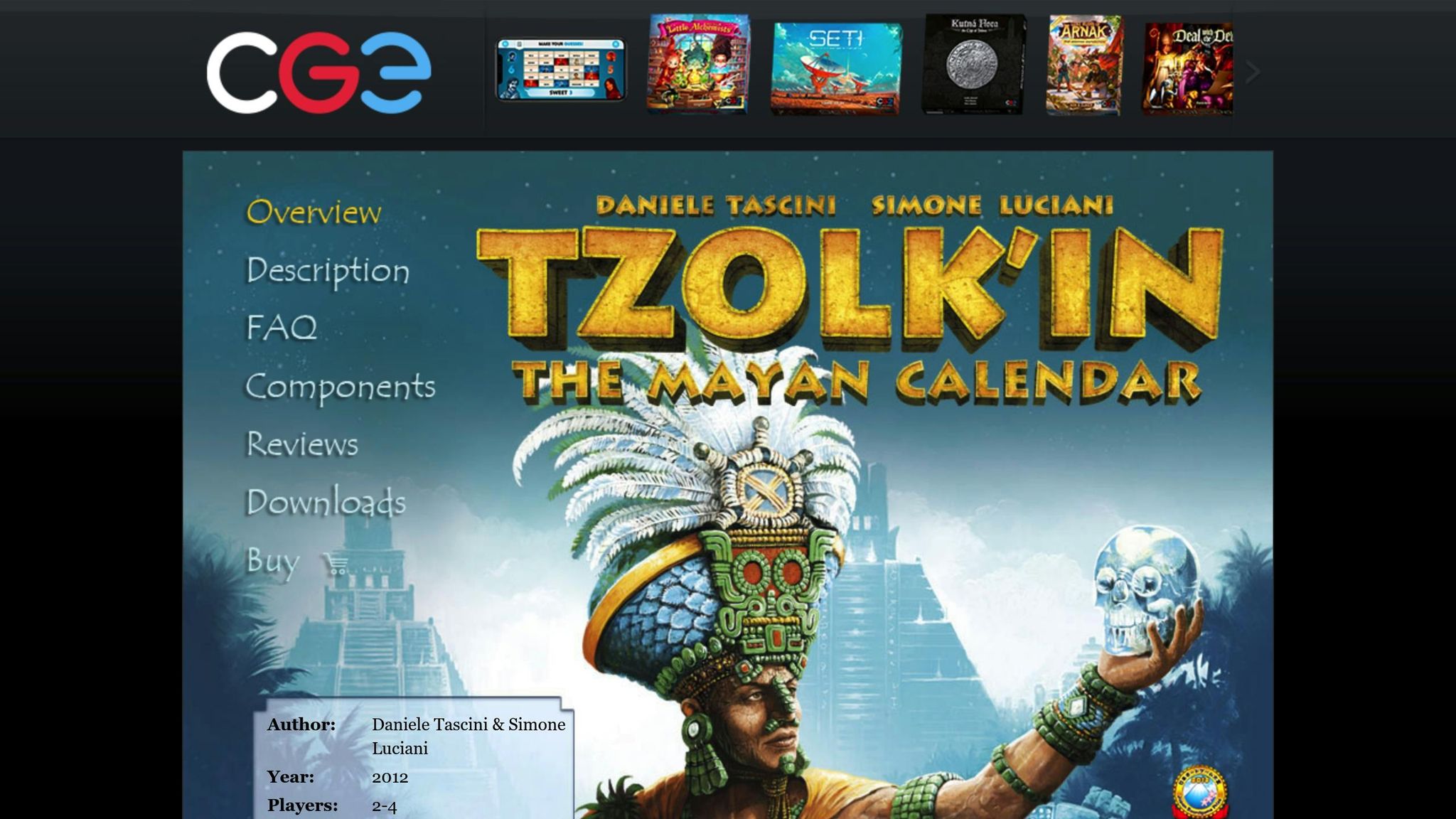Discover the Best Board Games for Every Player

Top 7 Solo Worker Placement Games
Looking for the best solo worker placement games? Here’s a quick rundown of seven standout titles that deliver strategic depth, engaging themes, and smart solo modes. Whether you’re managing resources, competing against AI rivals, or exploring immersive worlds, these games offer rewarding solo experiences:
- Dune: Imperium: Combines worker placement and deck-building in Frank Herbert’s universe with a smooth AI system and adjustable difficulty.
- A Feast for Odin: Uwe Rosenberg’s Viking-themed game with a mix of resource management and polyomino tile placement.
- Lost Ruins of Arnak: Blends deck-building and worker placement in an exploration-themed adventure.
- Everdell: A woodland-themed engine-builder featuring seasonal progression and a competitive AI opponent.
- Agricola (Revised Edition): A classic farming simulation with tight resource management and campaign options.
- Tzolk’in: The Mayan Calendar: A timing-focused game using interconnected gear mechanics for unique challenges.
- Viticulture Essential Edition: Manage a vineyard while competing against a clever AI in a seasonal worker placement system.
Each game offers a unique twist on solo worker placement mechanics, from Viking raids to winemaking. Dive into the full article to explore strategies, features, and tips for each title.
Best Worker Placement Solo Games
How We Chose These Games
We based our selection on four key factors: replay value, clarity of solo game rules, how well the theme is integrated, and the complexity of decisions. This approach helped us focus on games that deliver an engaging solo experience while staying true to the worker placement mechanics. The goal was to find games that successfully adapt multiplayer dynamics into enjoyable solo play.
Replay Value and Cost Considerations
We looked at how much replayability each game offers and how well it justifies its price. Games with adjustable difficulty levels and engaging campaigns stood out.
Solo Rules Clarity
The quality of solo rules was a major factor. We gave preference to games that retained the essence of worker placement while being easy to set up and play solo.
Theme and Mechanics Connection
We evaluated how well each game’s mechanics tied into its theme, going beyond just visuals. Player surveys show Sci-fi, Medieval, and Fantasy themes are particularly popular. Games that blended their narrative elements with the worker placement mechanics scored higher in our review.
Strategic Depth
The complexity of decisions was another important aspect. As Cardboard Clash puts it:
"Complexity in his games do not come from understanding the actions, but how it all intertwines with the mechanisms in order to get things humming along and churn out the objective you're trying to accomplish."
We prioritized games where straightforward mechanics led to meaningful strategic decisions, making them accessible yet deeply rewarding.
Using this detailed approach, we identified top-tier solo worker placement games that excel in these areas.
1. Dune: Imperium

Dune: Imperium blends deck-building and worker placement mechanics to offer a solo gaming experience steeped in the political intrigue of Frank Herbert's universe. Here's a closer look at how its solo mode works.
-
Solo Mode Design
In solo play, you face off against two rival leaders, simulating the feel of a three-player game. The focus is on keeping gameplay smooth rather than bogging it down with overly complex AI. Designer Paul Dennen explains:
"I am not fond of automated opponents where you must go through a series of rules to achieve a 'relatively smart' play. I'd rather have the opponent play somewhat randomly but fast, as long as on average, it makes reasonable plays and the sum of its parts provides a reasonable challenge."
-
Difficulty Options
The game offers four difficulty levels, making it easy to adjust the challenge as you improve. Rivals automatically gather resources and turn them into victory points, ensuring consistent pressure without overwhelming complexity. -
Digital Companion App
A companion app simplifies solo play by automating the House Hagal deck used by rival leaders. This reduces setup time while keeping the gameplay engaging and tactical. -
IGN's Take
IGN reviewer Matt Thrower praised the game, noting:
"Dune: Imperium is an impressive game that's accessible, varied, and has an appeal that reaches across a wide range of gaming tastes."
-
Winning Strategies
To succeed, you’ll need to carefully manage conflicts and resources to block rivals from gaining victory points. Reaching the 10-point victory threshold requires smart planning and precise timing.
This thoughtful design earned Dune: Imperium a nomination for the 2022 Kennerspiel des Jahres award, highlighting its place as a top-tier solo board game.
2. A Feast for Odin

This solo worker placement game by Uwe Rosenberg stands out for its mix of resource management and polyomino tile placement. In the game, players expand their Viking empire by arranging irregular tiles on personal boards, adding a layer of strategy that keeps gameplay engaging. These features make it a strong contender for any solo gaming list.
The solo mode introduces unique challenges. Players alternate between two colored meeples, with each staying on the board for an additional turn. This mechanic demands precise planning, especially as the action board offers over 60 different choices.
Patrick Korner of Opinionated Gamer highlights:
"The spatial element that the board brings, and the decisions that 'stronger actions need more workers' create elevates this, at least in my opinion, beyond the usual worker placement fare."
Solo play can follow three main strategies:
- Whaling Path: Focus on acquiring large blue tiles early.
- Pillaging Route: Prioritize raids for quick rewards.
- Hybrid Approach: Balance hunting, trapping, and crafting efforts.
For a strong start, aim for an income of 2 silver in the first turn and secure both a boat and an expansion board by the second turn. The occupation cards add variety, offering multiple ways to achieve victory.
To maximize efficiency, target grey U and E-shaped tiles early to unlock bonus goods. Alternating between large blue and green tiles helps cover negative spaces effectively. Long-term planning is essential, especially when using the Homecomer occupation card in round 7, which allows three powerful 4-Viking actions. Tabletop Gaming describes it as a "rich, hugely rewarding experience" that expertly balances theme, strategy, and tension.
3. Lost Ruins of Arnak

Lost Ruins of Arnak combines worker placement and deck building in a way that stands out. Ranked #28 on BoardGameGeek, it challenges players to manage resources and time their moves strategically.
The game's design stems from Czech Games Edition's creative approach. Designer Mín from the team shared:
"This was an experiment, we tried to combine two mechanics we both love, which is worker placement and deck building."
Each turn forces players to decide: should they use cards for their effects or spend them to move archaeologists? This balance is the heart of the game, supported by mechanics that work seamlessly together:
- Evolving Worker Actions: Exploring the island unlocks new spots for player actions.
- Resource-Based Actions: Some moves depend on spending resources instead of placing workers.
- Strategic Card Use: Cards can be used for immediate effects or as travel tools, adding layers of strategy.
The game’s replayability is boosted by variable map setups and artifact placements. Its detailed artwork and high-quality components immerse players in the exploration theme, making every discovery feel rewarding.
The multifunctional cards deepen the strategy, requiring players to think carefully about when to act and how to convert resources effectively. These decisions, especially in solo play, can make or break a player's journey toward success.
sbb-itb-1ed942f
4. Everdell

Everdell combines engine-building gameplay with a captivating woodland theme. Since its release in 2018, it has sold over 250,000 copies and is especially praised for its solo mode.
The game introduces a seasonal progression system that adds depth to the worker placement mechanic. Players start with two workers in winter and gradually gain more as the seasons progress. Here's how it works:
| Season | Workers Added | Special Actions |
|---|---|---|
| Winter | Start with 2 workers | Set up the game |
| Spring | Gain 1 worker | Activate production cards |
| Summer | Gain 1 worker | Draw 2 meadow cards |
| Autumn | Gain 2 workers | Activate production cards |
This seasonal flow keeps the gameplay dynamic and engaging, with each phase presenting fresh challenges. In solo mode, players compete against Rugwort, an AI opponent with three adjustable difficulty levels. Each turn involves choosing between placing a worker or playing a card, making resource management and careful planning essential.
The scarcity of resources pushes players to think strategically, while the changing seasons bring chances to activate production cards and recover workers. Combined with its breathtaking artwork and immersive design, Everdell has earned its place as a standout solo game.
5. Agricola (Revised Edition)

Uwe Rosenberg's classic farming game gets a new twist with this revised edition, designed to shine in solo play. It offers an immersive farming simulation where you’ll juggle limited resources to grow your farm from scratch.
In solo mode, you begin with two family members and no food, making every decision crucial. Harvest cycles are a key challenge - each adult requires three food per harvest, and failing to meet this need results in penalties. Here’s how it works:
| Phase | Food Requirement | Consequence |
|---|---|---|
| Initial Setup | 0 food | Start with 2 workers |
| Each Harvest | 3 food per adult | Penalties for failing to feed |
| Family Growth | Additional food cost | More actions but higher food demand |
This edition improves on the original with upgraded components and a more refined action system. The solo mode benefits from an open action space, turning every choice into a strategic challenge. Updates include all-wood components and a carefully selected mix of cards from the base game and expansions.
A reviewer described it best: "Agricola is a fascinating design of grueling trade-offs. Players have to manage their limited actions and resources and use these to build something great."
To succeed, you’ll need to balance multiple tasks: planting crops, raising animals like sheep and cattle, expanding your home, and growing your family to unlock more actions. Optional campaign rules add depth, but mismanagement can lead to harsh penalties. Pre-arranging components can also help speed up setup.
6. Tzolk'in: The Mayan Calendar

Tzolk'in is a standout solo worker placement game, thanks to its gear-driven mechanics. At the heart of the game is the iconic calendar wheel, which connects to smaller gears. Each turn, workers automatically advance, creating a timing puzzle that adds depth to resource management.
The solo mode introduces a virtual opponent governed by dice rolls and a separate rulebook. However, this opponent isn't without its challenges. Kristofer Solomon from Board Game Breakdown shares:
"The biggest negative is that the virtual player is so overpowered that I almost don't understand how I could possibly win. I don't mind a challenge, but this is almost unmanageable."
This difficulty aligns with the game's BoardGameGeek weight rating of 3.67, placing it among the more complex games on this list. The mechanics in solo mode differ significantly from multiplayer play:
| Aspect | Solo Mode | Multiplayer Mode |
|---|---|---|
| Worker Removal | Virtual player keeps workers | Players must remove them strategically |
| Resource Management | Virtual player skips resource costs | Players manage limited resources |
| Game Balance | Favors the virtual player | Balanced for all players |
These differences demand a shift in strategy for solo players. Experts offer insights to navigate the game's challenges. Eleon from BoardGameGeek recommends:
"To win Tzolk'in you need to have lots of actions and have them be the more powerful ones. This means getting workers to the top of the gears ASAP."
Similarly, VikingErik advises:
"Buying directly up high on a wheel is in general the strongest move you can do. The rewards are virtually always worth more than the corn paid to buy up."
The game's central calendar keeps players on their toes, requiring careful decisions about when to place or retrieve workers. There's also the unique option to advance the calendar by two days instead of one, adding another layer of strategy.
Tzolk'in’s gear system offers a rich puzzle of timing and resource planning. As Tom Franklin puts it:
"It's also a game that, once I've finished playing, I pause briefly before playing another round."
7. Viticulture Essential Edition

Viticulture Essential Edition offers a strong solo gaming experience. In this game, you manage a Tuscan vineyard while competing against an AI opponent called the Automa. Using a seasonal worker placement system, your goal is to score over 20 points in seven rounds, all while the Automa strategically blocks key actions. This solo mode was designed by Morten Monrad Pedersen.
Here’s how the game flows through its seasons:
| Season | Focus | Key Actions |
|---|---|---|
| Summer | Vineyard Development | Planting vines and building structures |
| Winter | Production | Harvesting, winemaking, and fulfilling orders |
| Spring/Fall | Special Actions | Drawing cards and activating bonus actions |
This seasonal rhythm creates a clear and engaging structure for gameplay.
One standout element is the Grande worker, which allows you to bypass a blocked action space once per year. Pair this with bonus actions earned through glass tokens on the wake-up track, and you’ll find a layer of tactical depth that rewards careful planning. Managing resources for structures and worker training is especially important.
The solo mode is well-balanced, with normal difficulty offering a win rate of less than 50% for most players. However, seasoned players tend to perform much better. Success hinges on efficient winemaking and clever use of visitor cards.
To thrive, focus on building essential infrastructure early - like trellises, irrigation systems, and cellars. Be prepared to adapt when the Automa blocks key actions. Fulfilling orders early on is also crucial, as it generates residual income that keeps your vineyard running smoothly throughout the seven rounds.
Final Thoughts
Solo worker placement games have grown into a genre that offers unique challenges and engaging gameplay. The seven games highlighted here demonstrate how this style of play combines thoughtful mechanics with strategic depth to create rewarding solo experiences.
Each game strikes its own balance between straightforward gameplay and intricate strategy, catering to players of varying skill levels. A common thread across these titles is the focus on managing limited resources and actions, making every decision feel impactful. This design choice emphasizes the tension and weight of solo play, even without direct competition from other players.
Many of these games also expand their appeal with cooperative modes and add-ons. For instance, the Tuscany expansion for Viticulture introduces new strategic elements while staying true to the game's core mechanics, adding even more depth for solo players.
These games succeed because they challenge players in meaningful ways, turning struggles into rewarding victories. As Jim Gamer from WhatBoardGame.com aptly states:
"Without a struggle there would be no reward."






